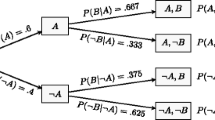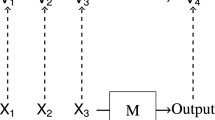Abstract
The argument from silence is a pattern of reasoning in which the failure of a known source to mention a particular fact or event is used as the ground of an inference, usually to the conclusion that the supposed fact is untrue or the supposed event did not actually happen. Such arguments are widely used in historical work, but they are also widely contested. This paper surveys some inadequate attempts to model this sort of argument, offers a new analysis using a Bayesian probabilistic framework that isolates the most problematic step in such arguments, illustrates a key problem besetting many uses of the argument, diagnoses the attraction of the argument in terms of a known human cognitive bias affecting the critical step, and suggests a standard that must be met in order for any argument from silence to have more than a very weak influence on historical reasoning.
Similar content being viewed by others
Notes
Sir Arthur Conan-Doyle, “Silver Blaze,” in The Complete Sherlock Holmes (New York: Doubleday & Co., 1988), p. 347. That someone had entered the stables at night and abducted the race horse Silver Blaze is already established; the dog, although trained to guard the stables, gave no alarm. Holmes employs the argument from silence to narrow the field of possible suspects to people familiar to the dog—hence its silence in the night. This incident has proved suggestive for several different philosophical explorations: it is used as an illustration of the interrogative method of scientific inquiry in Hintikka and Hintikka, “Sherlock Holmes confronts modern logic: toward a theory of information-seeking through questioning,” in E. M. Barth and J. L. Martens, eds., Argumentation: Approaches to Theory Formation (Amsterdam: John Benjamins, 1982), pp. 55–76, whereas Peter Lipton, Inference to the Best Explanation, 2nd ed. (New York: Routledge, 2004), p. 116, construes it as an inference to the best explanation, as do Walter Sinnott-Armstrong and Robert Fogelin in Understanding Arguments: An Introduction to Informal Logic, 8th ed. (Belmont, CA: Wadsworth Cengage Learning, 2010), pp. 259–60.
Julius Wellhausen, Prolegomena to the History of Israel (Edinburgh: Adam & Charles Black, 1885), p. 365.
Walter Leaf, “Reichel on the Homeric Armour,” The Classical Review 9 (London: David Nutt, 1895), p. 55.
Mabel Gude, A History of Olynthus (Baltimore: Johns Hopkins Press, 1933), p. 19. Gude’s comment here is prompted by the omission of any mention of the Chalcidian League in the work of Thucydides. Similar deprecatory assessments of the form of the argument might be quoted almost ad infinitum, e.g. William Thomas Arnold, Studies of Roman Imperialism (Manchester: University Press, 1906), p. 89, note 1; Rachel Robertson Reid, The King’s Council in the North (London: Longmans, Green & Co., 1921), p. 73; Richard D. Mohr, The Platonic Cosmology (Leiden: Brill Academic Publishers, 1985), pp. 159–60; David R. Hall, The Unity of the Corinthian Correspondence (New York: T. & T. Clark, 2003), p. 64.
George Edmundson, The Church in Rome in the First Century (London: Longmans, Green and Co., 1913), pp. 62–63. Similarly strong language regarding the argument from silence crops up in many historical works, e.g. Edward Moore, Studies in Dante, third series (Oxford: Clarendon Press, 1903), p. 131; W. A. Goligher, “Studies in Attic Law,” Hermathena 14 (Dublin: Hodges, Figgis, & Co., 1907), p. 515.
J. B. Lightfoot, Essays on the Work Entitled Supernatural Religion (London: Macmillan and Co., 1889), p. 84; Hugo Radau, Letters to Cassite Kings from the Temple Archives of Nippur (Philadelphia: Department of Archaeology, University of Pennsylvania, 1908), p. 23; cf. George W. Elderkin, “The Fountain of Glauce at Corinth,” American Journal of Archaeology 14 (New York: Macmillan, 1910), p. 43; Peter R. Ackroyd and Christopher Francis Evans, The Cambridge History of the Bible: From the Beginnings to Jerome (Cambridge: Cambridge University Press, 1975), p. 123; Nicholas Cahill, Household and City Organization at Olynthus (New Haven: Yale University Press, 2001), p. 187; Peter Jackson, “Marco Polo and his ‘Travels’,” in Gerald R. Hawting, ed., Muslims, Mongols, and Crusaders (New York: Routledge, 2005), p. 278.
The principal sources that treat the argument from silence in some detail, though with very uneven levels of formal and philosophical sophistication, are C. A. Briggs, “The Argument E Silentio: With Special Relation to the Religion of Israel,” Journal of the Society of Biblical Literature and Exegesis 3 (1883), pp. 3–21; Andrew Constantinides Zenos, The Elements of the Higher Criticism (New York: Funk & Wagnalls, 1895), pp. 74–94; Charles de Smedt, S. J., Principes de la critique historique (Paris: Librarie de la Societe Bibliographique, 1883), chapters 13 and 14; Charles Victor Langlois and Charles Seignobos, Introduction to the Study of History, trans. G. G. Berry (New York: Henry Holt and Co., 1904), chapter 3; John Lange, “The Argument from Silence,” History and Theory 5 (1966), pp. 288–301; David P. Henige, Historical Evidence and Argument (Madison: University of Wisconsin Press, 2005), chapter 16; and Elliott Sober, “Absence of Evidence and Evidence of Absence: Evidential Transitivity in Connection with Fossils, Fishing, Fine-tuning, and Firing Squads,” Philosophical Studies 143 (2009), pp. 63–90.
Lange (1966), p. 298.
See the discussion in Timothy and Lydia McGrew, “The Reliability of Witnesses and Testimony to the Miraculous.” With Lydia McGrew. In Jake Chandler and Victoria Harrison, eds., Probability in the Philosophy of Religion (Oxford: Oxford University Press, 2012), pp. 46–63.
See the references in Douglas Walton, Arguments from Ignorance (University Park, PA: Pennsylvania State University Press, 1996), pp. 2–5 and 25–28; but note the reservation expressed by Copi, cited in Walton pp. 34–35.
Ibid., pp. 28–36.
Ibid., p. 67.
See Langlois and Seignobos (1904), p. 256, who seem to be offering (3) and (4) as instances in which the argument from silence is conclusive.
See Leaf (1895), p. 56.
The earliest known probable reference is in a document written by Pope Adrian I, who died in 795.
Walton (1996), p. 252.
De Smedt (1883), p. 227; cf. Langlois and Seignobos (1898), p. 256; Lange (1966), pp. 290–93. Unlike the earlier authors, Lange recognizes the problems with such analyses.
This qualification is suggested by an observation made by Lange (1966), p. 294, though in a slightly different context.
Clemens Reichel, “A Modern Crime and a Ancient Mystery: the seal of Bilalama,” in Gebhard Selz, ed., Alter Orient und Altes Testament 274 (2003) p. 355.
Henige (2005), p. 175. Henige castigates Reichel’s view as “prodigiously nonsensical—and technically indefensible.”
Henige (2005), p. 174.
That is to say, from “If P, then very probably Q” and “Not Q,” we cannot legitimately infer “Not P,” since (by contrast with the deductive case of modus tollens) we need additional information about how probable Q would be if P were false before we are entitled to draw a conclusion, even probabilistically. This is a point correctly stressed by Elliott Sober in Evidence and Evolution: the Logic behind the Science (Cambridge: Cambridge University Press, 2008), pp. 48–57 and 353–54.
That is to say, the ratio P(~H)/P(H).
By the Theorem on Total Probability, P(E|H) = P(N & R & S|H) × P(E|N & R & S & H) + P(~N ∨ ~ R ∨ ~ S|H) × P(E|(~N ∨ ~ R ∨ ~ S) & H). Since ex hypothesi (N & R & S) entails E, P(E|N & R & S & H) = 1; we can therefore simplify the algebraic expression for P(E|H) by dropping that term, yielding P(E|H) = P(N & R & S|H) + [P(~N ∨ ~ R ∨ ~ S|H) × P(E|(~N ∨ ~ R ∨ ~ S) & H)]. Expanding P(N & R & S|H) into a series of simpler conditional probabilities by successive applications of the conjunction rule yields P(N|H) × P(R|H & N) × P(S|H & N & R). By substitution, we arrive at P(E|H) = [P(N|H) × P(R|N & H) × P(S|R & N & H)] + [P(~N ∨ ~ R ∨ ~ S|H) × P(E|H & (~N ∨ ~ R ∨ ~ S))].
In all of these scenarios, we are assuming that the extra term [P(~N ∨ ~ R ∨ ~ S|H) × P(E|H & (~N ∨ ~ R ∨ ~ S))] is zero. Any positive value of that term will in most circumstances be so small as to have a negligible effect on the force of the argument from silence.
See Edgar Whittlesey Camp and John Finley Crowe, eds., The Encyclopedia of Evidence, vol. 9 (Los Angeles: L. D. Powell Co., 1906), pp. 867–68, in particular the cases cited in notes 10–13.
“To entitle the testimony of a witness that he did not see or hear a certain thing occur at a particular time and place, to the same weight upon the question of whether it did occur or not, as that of an equally credible witness that he saw or heard the occurrence in question, it must appear that the opportunities of the former were at least equal to those of the latter, and that his attention was specially directed to the matter; and whether this was so or not is to be determined, not merely from his own opinion or statement that the occurrence could not have taken place without his seeing or hearing it, but from all the evidence bearing on the subject.” Killian v. Georgia R. & B. Co., 97 Ga 727, 25 S. E. 384. Quoted in Camp and Crowe, The Encyclopedia of Evidence, vol. 9, p. 870, note 19.
Henige (2005), p. 75.
Rory Dunlop and Jón Vidar Sigurdsson, “An Interdisciplinary Investigation of Bergen’s Forgotten Fire: Confrontation and Reconciliation,” Norwegian Archaeological Review 28 (1995), pp. 73–92.
Henige (2005), p. 75.
Langlois and Seignobos (1904), p. 256.
Frederick Pollock, “Benedict de Spinoza,” The Nineteenth Century 3 (London: C. Kegan Paul & Co., 1878), pp. 338–39.
On this point see J. Cohen, E. I. Chesnick, and D. A. Haran, “Evaluation of Compound Probabilities in Sequential Choice,” Nature 232 (1971), pp. 414–16, and “A Confirmation of the Inertial-ψ Effect in Sequential Choice and Decision,” British Journal of Psychology 63 (1972), pp. 41–46, M. Bar-Hillel, “On the Subjective Probability of Compound Events,” Organizational Behavior and Human Performance 9 (1973), pp. 396–406, and Raymond S. Nickerson, Cognition and Chance: The Psychology of Probabilistic Reasoning (Mahwah, NJ: Lawrence Earlbaum Associates, 2004), pp. 290 and 342–43.
Some research (e.g. Kahneman and Tversky, “On the Study of Statistical Intuitions,” in Judgment Under Uncertainty (New York: Cambridge University Press, 1982), pp. 493–508) suggests that a bias in favor of representativeness will frequently lead reasoners to make incoherent probability judgments regarding P(A&B) and P(B). Recent attempts to reproduce this result seem to indicate that it is less robust than Kahneman and Tversky originally thought. But in the case at hand, the effect of conjunction need not be so radical as to introduce this sort of incoherence; it suffices that our unreflective judgment of P(N&R&S|H) tends to be significantly greater than that of the equivalent product P(N|H) × P(R|N & H) × P(S|R & N & H).
Author information
Authors and Affiliations
Corresponding author
Rights and permissions
About this article
Cite this article
McGrew, T. The Argument from Silence. Acta Anal 29, 215–228 (2014). https://doi.org/10.1007/s12136-013-0205-5
Received:
Accepted:
Published:
Issue Date:
DOI: https://doi.org/10.1007/s12136-013-0205-5




